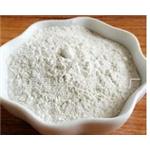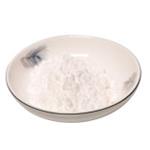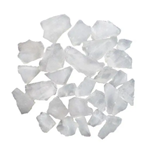Also known as potash alum, alum NF, and potassium alum, Al2(S04)3.K2S04.24H20 (sometimes written AlK(S04)2·12H20) is white, odorless crystals having an astringent taste, and is soluble in water, insoluble in alcohol, and noncombustible. Solutions in water are acid. Derived from alumite, leucite, or similar minerals, and also by crystallization from a solution made by dissolving aluminum sulfate and potassiwn sulfate and mixing, Used in dyeing (mordant), paper, matches, paints, tanning agents, waterproofing agents, purification of water, aluminum salts, food additive, baking powder, astringent, and as a cement hardener.
The PhEur 6.0 describes potassium alum as a granular powder, or
colorless, transparent, crystalline masses. The JP XV describes it as
colorless or white crystals or powder. Potassium alum is odorless
and has a slightly sweet, strongly astringent taste.
white powder(s); absorbs atmospheric moisture [MER06]
ChEBI: A metal sulfate composed of potassium, aluminium and sulfate ions in the ration 1:1:2.
Potassium alum is manufactured by treating bauxite with sulfuric
acid and then potassium sulfate. Alternatively, aluminum sulfate is
reacted with potassium sulfate.
Flammability and Explosibility
Non flammable
Pharmaceutical Applications
Potassium alum precipitates proteins and is a powerful astringent.
The ability to precipitate proteins is utilized in the manufacture of
vaccines, where purified proteins are coprecipitated with and
adsorbed onto potassium alum.
Potassium alum is often included in preparations used as
mouthwashes or gargles and in dermatological preparations, and
it may be used as a topical hemostatic, either as a solid or as a
solution. Intravesical instillation of potassium alum, typically as a
1% solution, has been used for hemorrhagic cystitis.
Potassium alum is often included in preparations used as
mouthwashes or gargles and in dermatological preparations.
Large doses of potassium alum act as an irritant and may be
corrosive; gum necrosis and gastrointestinal hemorrhage have
occurred. Acute encephalopathy has been reported following
bladder irrigation with alum solutions in the treatment of bladder
hemorrhage. Anecdotal evidence suggests that this practice should
be avoided for patients with renal insufficiency.
Store in a cool, dry place in tightly closed containers. Stable under
normal temperatures and pressures. When kept for a long time at
60–65°C (or over sulfuric acid) potassium alum dodecahydrate
loses water, which is reabsorbed on exposure to air. It becomes
anhydrous at about 200°C.
Potassium alum is incompatible with strong oxidizing agents,
aluminum, copper, steel, and zinc. When it is dispensed in powders
with phenol, salicylates, or tannic acid, gray or green colors may be
developed owing to traces of iron in the alum.
GRAS listed. Included in the FDA Inactive Ingredients Database
(vaginal; suppository). Included in medicines licensed in the UK.



